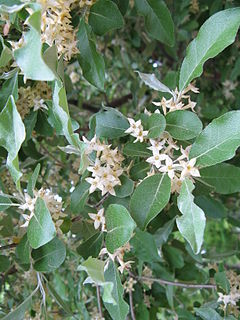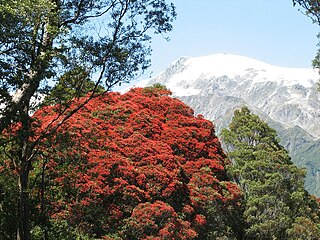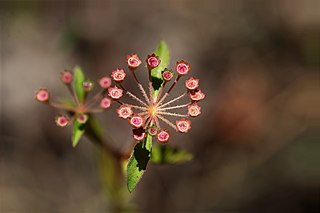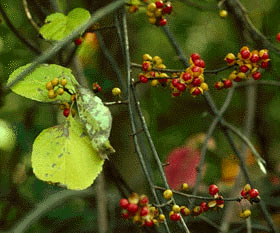
Elaeagnus umbellata is known as Japanese silverberry, umbellata oleaster, autumn olive, autumn elaeagnus, or spreading oleaster. The species is indigenous to eastern Asia and ranges from the Himalayas eastwards to Japan.

Elaeagnus, silverberry or oleaster, is a genus of about 50–70 species of flowering plants in the family Elaeagnaceae.

Metrosideros umbellata, the southern rātā, is a tree endemic to New Zealand. It grows up to 15 metres (49 ft) or more tall with a trunk up to 1 metre or more in diameter. It produces masses of red flowers in summer. Unlike its relative, northern rātā, this species rarely grows as an epiphyte.

Eucalyptus tereticornis is a species of tree native to eastern Australia. E. tereticornis has several common names, including forest red gum, blue gum, flooded gum, grey gum, mountain gum, Queensland blue gum, red gum, bastard box, red ironbark, red irongum and slaty gum.

Comandra is a monotypic genus containing the single species Comandra umbellata. Its common names include bastard toadflax, umbellate bastard toadflax, and common comandra. The plant has a disjunct distribution; its four subspecies occur in North America and the Mediterranean.

Stackhousia is a genus of annual and perennial plants in the family Celastraceae that are native to Australia, New Zealand, Malesia and Micronesia. The genus was first described by James Edward Smith in Transactions of the Linnean Society of London in 1798.

Cistanthe umbellata is a species of flowering plant in the purslane family known by the common name Mount Hood pussypaws. It is native to western North America from British Columbia to California to Colorado, where it grows in a number of habitat types, including in areas inhospitable to many plant types, such as those with alpine climates. It is a perennial herb forming generally two or more basal rosettes of thick, spoon-shaped leaves each a few centimeters long. The inflorescence arises from the rosette, a dense, spherical umbel of rounded sepals and four small petals. A smaller subgroup of Cistanthe umbellatum are located in the Zayante Sandhills, a biological island in the Santa Cruz Mountains. These individuals reside on a singular hill in the entirety of the sandhills, and their frail petals and loose seeds allow for easy wind dispersal provided by the hill's location.
Stackhousia subterranea is a perennial herb species in the family Celastraceae. The species occurs in South Australia and Victoria and Tasmania

Stackhousia viminea the Slender Stackhousia is a common small Australian plant. It grows to 70 cm tall. The habitat is heathland, pastures, eucalyptus woodland and forest, usually in moist areas. It features attractive yellowish/red flowers. The specific epithet viminea refers to the slender stems. The genus is named after the botanist and artist, John Stackhouse

Melochia umbellata is a species of flowering plant in the mallow family, Malvaceae. Its specific epithet comes from the Latin umbellatus (umbel-like), referring to the inflorescence.

Stackhousia monogyna, commonly known as creamy stackhousia or creamy candles, is a perennial herb species in the family Celastraceae. It is native to Australia. Plants grow to 70 cm (28 in) high and produce a terminal spike of white, cream or yellow flowers between August and January in the species native range.

Stackhousia clementii is a species of plant in the Celastraceae family.
Stackhousia dielsii, commonly known as yellow stackhousia, is a species of plant in the Celastraceae family.
Stackhousia huegelii is a species of plant in the Celastraceae family.

Stackhousia muricata is a species of plant in the Celastraceae family.
Stackhousia pubescens, commonly known as downy stackhousia, is a species of plant in the Celastraceae family.
Stackhousia scoparia is a species of plant in the Celastraceae family.
Stackhousia stratfordiae is a species of plant in the Celastraceae family.

Pomax is a genus of flowering plants in the coffee family, Rubiaceae. Pomax umbellata, found in Australia, is the sole species of the genus. The genus was created in 1830, by the Swiss taxonomist Augustin Pyramus de Candolle, published in his Prodromus Systematis Naturalis Regni Vegetabilis. Pomax umbellata was described in 1834.

Boronia umbellata, commonly known as the Orara boronia, is a plant in the citrus family Rutaceae and is endemic to a small area on the north coast of New South Wales. It is an erect shrub with many branches, aromatic, pinnate leaves and clusters of up to ten dark pink flowers in the leaf axils.
















